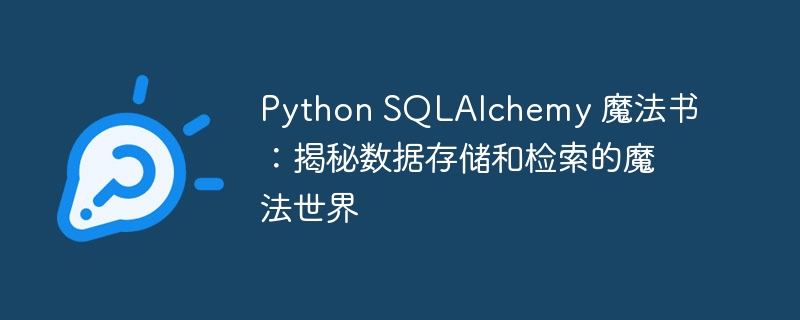Home >Backend Development >Python Tutorial >Python SQLAlchemy Magic Book: Revealing the Magical World of Data Storage and Retrieval
Python SQLAlchemy Magic Book: Revealing the Magical World of Data Storage and Retrieval
- PHPzforward
- 2024-02-25 08:16:26757browse

sqlBasic concepts of Alchemy
SQLAlchemy is an object-relational mapping (ORM) tool based on python that allows developers to use Python Objects interact with relational databases. ORM is a technology that maps data in a relational database to Python objects in memory. It can greatly simplify data access logic and reduce the amount of code writing. The core idea of SQLAlchemy is to map tables in a relational database to Python classes, and rows in a relational database to instances of Python objects. Through this mapping, developers can use Python code to operate data in relational databases without directly writing SQL statements.
Basic usage of SQLAlchemy
The basic usage of SQLAlchemy is very simple. First, you need to create an Engine object, which will be responsible for connecting to the relational database. Then, you need to create a Sess
ion object, which will be responsible for managing the interaction with the relational database. Next, you can define one or more classes to map tables in the relational database, and define corresponding properties in these classes to map columns in the relational database. Finally, you can use the Session object to query, insert, update, and delete data. The following is a simple example that demonstrates how to use SQLAlchemy to connect to a database, define a class to map a table, and query data:
from sqlalchemy import create_engine, Column, Integer, String
from sqlalchemy.orm import sessionmaker
# 创建一个Engine对象
engine = create_engine("sqlite:///test.db")
# 创建一个Session对象
Session = sessionmaker(bind=engine)
session = Session()
# 定义一个类来映射表
class User(Base):
__tablename__ = "user"
id = Column(Integer, primary_key=True)
name = Column(String(50))
# 查询数据
users = session.query(User).all()
# 打印查询结果
for user in users:
print(user.name)
In the above example, we first created an Engine object that will be responsible for connecting to the SQLite database named test.db. We then created a Session object that will be responsible for managing interaction with the database. Next, we define a class named User to map the user table. This class contains two attributes: id and name, which are mapped to the id column and name column in the user table respectively. Finally, we use the Session object to query all data in the user table and print the query results.
SQLAlchemy’s common
Interview questionsSQLAlchemy is a very broad
framework, so you may encounter a variety of questions during the interview. Here are some common SQLAlchemy interview questions:
What is SQLAlchemy?- What are the basic concepts of SQLAlchemy?
- What is the basic usage of SQLAlchemy?
- How does SQLAlchemy interact with relational databases?
- How does SQLAlchemy map tables in relational databases to Python classes?
- How does SQLAlchemy query, insert, update and delete data?
- How does SQLAlchemy handle foreign keys in relational databases?
- How does SQLAlchemy handle many-to-many relationships in relational databases?
- How does SQLAlchemy handle inheritance relationships in relational databases?
- How does SQLAlchemy handle concurrency
- control in relational databases? Conclusion
SQLAlchemy is a very powerful ORM framework that can greatly simplify the data storage and retrieval process. This article introduces the basic concepts, usage and some common
of SQLAlchemyThe above is the detailed content of Python SQLAlchemy Magic Book: Revealing the Magical World of Data Storage and Retrieval. For more information, please follow other related articles on the PHP Chinese website!
Related articles
See more- PHP example - PHP registration review key analysis (data access)
- An introduction to the functional operations of the PDO data access abstraction layer in PHP
- Detailed explanation of usage of sql statement case when
- How to update one table with another table through SQL statement
- What is the sql statement to delete a view?

